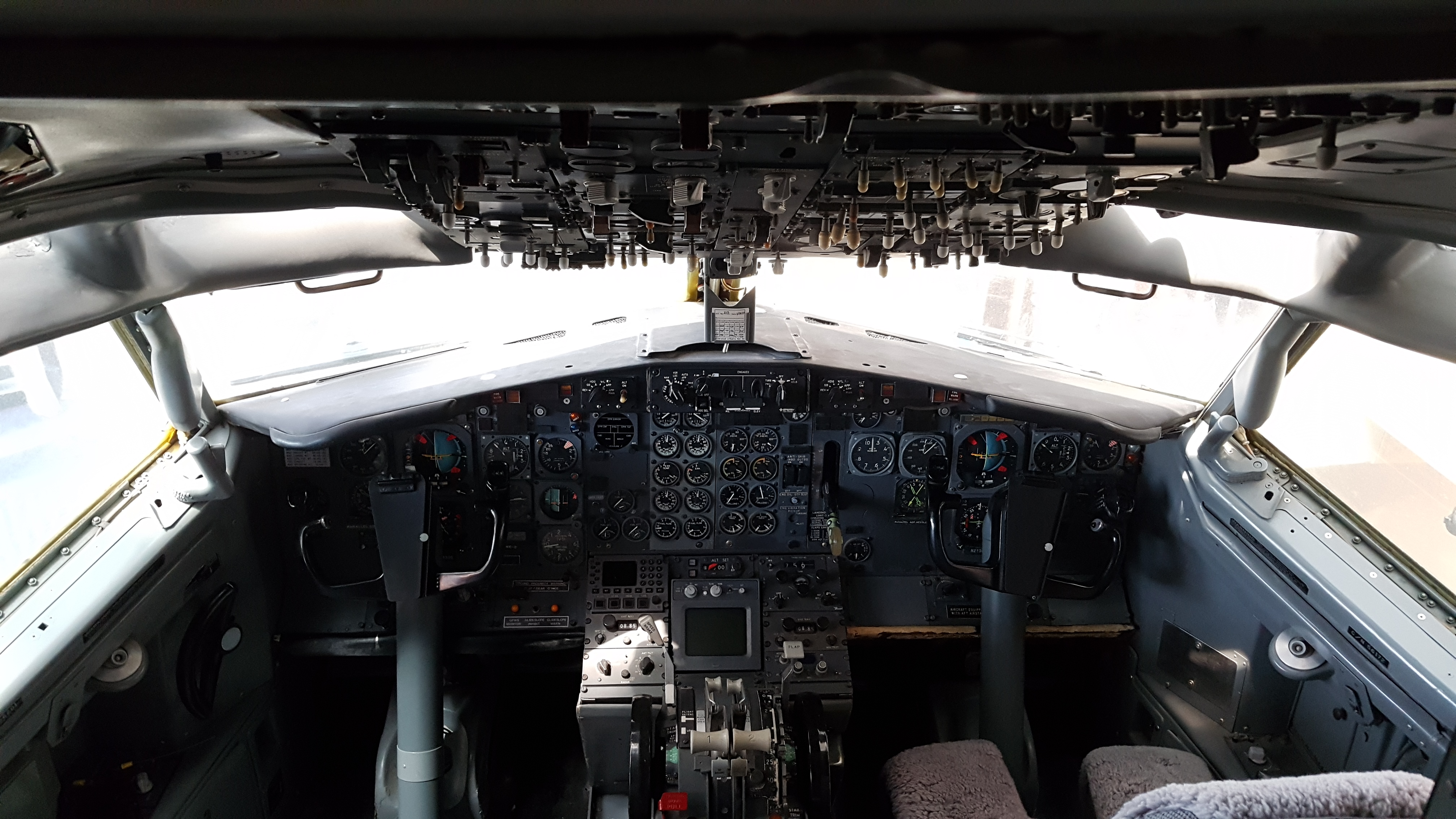This page was created by Jonas Pfeiffer.

This section aims to give you a rough overview of the things you can expect to see in the cockpit of a modern airliner. You can find an interactive 360° cockpit of an Airbus A 380 under the following link.
In the center console are further displays usually displaying engine information, fuel situation and
other basic information about the aircraft (please note that all displays are multi-function
and as such can display other information as well). There's also the landing gear
controls.
To the outside of a pilot's knees is a side-stick,
controlling pitch and roll
movements. Beside that is the controller steering the nose wheel on the ground (up to a point it can
be steered using the rudder pedals as is normal in aircraft, but for maximum deflection the hand
controller is needed).
The top of the center console (sunscreen) is occupied by the autopilot control panel. It allows to switch
autopilot modes (i.e. autoclimb, constant heading etc.) and to generally control the autopilot. It also
allows
to give targets for
airspeed, altitude, heading etc. Autothrottle
can also be controlled from
here.
Between the pilots are the controls for the flight management system
(FMS), the throttle quadrant, but also controls for the speed brakes (left) and the flaps (right).
Also located there are the trim controls, parking brake and fuel cocks (beneath the throttle
quadrant).
The overhead panel features engine controls, light controls, radio equipment, fuel system controls
and warnings, circuit breakers and other emergency equipment.
As you are probably well aware, aircraft need to be trimmed. Trimming most often uses trim tabs, small surfaces at the edges of
larger surfaces to trim these. In this way the smaller surface applies a torque to the lager one to balance
it. This works, because the center of pressure of the
trim ab is located farther from the hinge than the one of the main control surface.
Trimming can be useful to reduce stick (or rudder) forces and is available
for all three of the primary
flight controls (elevator, aileron and rudder) in most commercial aircraft. It is also used to
balance shifts in center
of gravity or thrust or to counteract (aerodynamic) imbalances in an aircraft.
The following video demonstrates the use of elevator trim in a general aviation aircraft.
Some aircraft especially in general aviation (GA) don't feature trim surfaces for all flight controls or none at all (usually only elevator). Elevator trim is commonly controlled by a trim wheel. Rotating the wheel forward makes the plane nose heavy. It looks like this in many GA planes. To the left of it you can see the trim indicator, although it usually only has one marking (take off). Commercial aircraft often feature a trim wheel between the pilots, as seen here. These wheels are motorized, so that they can move when the autopilot changes trim. In some commercial aircraft (i.e. McDonnell-Douglas MD-11) the trim situation can also be influenced by pumping fuel between tanks. Also, it is possible for most commercial aircraft to change the angle of incidence for the horizontal tail. This also changes trim and reduces drag compared to a conventional trim surface.
Rudder trim usually looks somewhat like this.
Rudder trim is essential in small very high powered piston-engined aircraft such as WWII fighter
aircraft (i.e. the Supermarine
Spitfire). Their engines produce a lot of torque and it is essential for safe take offs to
trim the aircraft against the resulting swing during the take off roll.
In modern jet-powered aircraft rudder trim is less essential, but still featured in commercial
aircraft.
Aileron trim, which is also uncommon in GA aircraft, is usually controlled by a switch or trim wheel. It can be used to eliminate rolling tendencies caused i.e. by differing fuel levels in the wings.
Historically the six most important flight instruments were often arranged directly in front of the pilot. These six are:
After the war, the irrevocable transition to the jet age changed cockpits a lot. The basic six were changed
to this arrangement (1-Airspeed
indicator, 2-AI, 3- altimeter, 4-TC, 5-HI, 6 VSI). At the beginning of jet air
transport, cockpits were very chaotic (see this
cockpit of a De Havilland Comet), but
subsequently got more organized after some accidents were blamed on the messy cockpit layouts. Also
understanding of workload grew and crew
resource management became a
thing after flight crews were trimmed to two pilots (omitting a flight engineer).
This
cockpit of a Boeing 737-200 shows an
intermediate step in cockpit evolution, still featuring analog round instruments.
A modern cockpit can be found at the top of the page. The much clearer and less
overwhelming delivery of information is obvious.
This photograph, showing the cockpit of a former US Air Boeing 737-201, was taken at the Museum of Flight in Seattle, WA in 2018. Their official website can be found here.